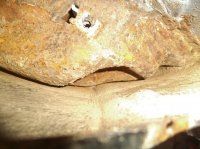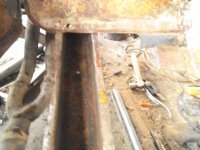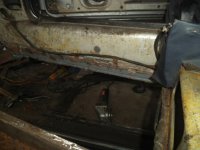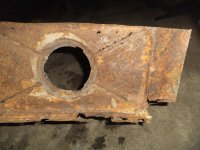tomcolitt
(deceased)
I thought I'd show some pictures of what we would consider a very "rust free" car here. It is not as good as the top cars, but better than 90% out there and I'm sure many of you have never seen a Coupe in this condition, even if you have taken off the baffle cover inside the fender and you might be interested to know what goes on in there when we're not looking.
The first picture shows the lower portion of the a-pillar which runs very close to the lower part of the fender skin. So close, in fact, that they almost touch in one very important spot. Many of you know this spot as the spot where rust first bubbles to the surface on the bottom portion outside the front fenders. Over time, sand collects and bakes in between these two pieces of sheet metal and it creates a nice (and in most places) moist sponge which causes the rusting at this point first. As the bottom of the a-pillar and rocker sections fills with this sand, these areas rust as well. As you can see from this car (it had just begun to show two very small rust bubbles on the outside of the lower fender), by the time the rust shows on the outside, the rust inside can already be fairly advanced. Of course, I did find that the two pieces of sheet metal were bridged with sand at exactly the spot where the rust bubbles appeared. The other pictures show how a car with this little rust looks in the floor pans. There was almost no rust or even pin holes visible from underneath the floor pan and only upon removing the sound deadening (and moisture and rust trapping) material on top of the floor pans as well as the undercoating below, did a series of small pin holes appear. Overall, it was nevertheless the better repair to replace the floor pan and I was able to cut out just the floor pan at the factory seams. The floor pan was quite severely pitted across the board while the inner portion of the rocker panel, which it is spot-welded to, was virtually untouched and still showed factory primer. Even the overlap joint where the floor pan joins the vertical lower firewall splash pan was separated at the factory seem with no damage. Not to be immodest. But, I don't think you will find many body shops able or willing to do this kind of repair in this precise way, even if they had the opportunity. I hope you enjoy these pictures as much as I did uncovering it all.
The first picture shows the lower portion of the a-pillar which runs very close to the lower part of the fender skin. So close, in fact, that they almost touch in one very important spot. Many of you know this spot as the spot where rust first bubbles to the surface on the bottom portion outside the front fenders. Over time, sand collects and bakes in between these two pieces of sheet metal and it creates a nice (and in most places) moist sponge which causes the rusting at this point first. As the bottom of the a-pillar and rocker sections fills with this sand, these areas rust as well. As you can see from this car (it had just begun to show two very small rust bubbles on the outside of the lower fender), by the time the rust shows on the outside, the rust inside can already be fairly advanced. Of course, I did find that the two pieces of sheet metal were bridged with sand at exactly the spot where the rust bubbles appeared. The other pictures show how a car with this little rust looks in the floor pans. There was almost no rust or even pin holes visible from underneath the floor pan and only upon removing the sound deadening (and moisture and rust trapping) material on top of the floor pans as well as the undercoating below, did a series of small pin holes appear. Overall, it was nevertheless the better repair to replace the floor pan and I was able to cut out just the floor pan at the factory seams. The floor pan was quite severely pitted across the board while the inner portion of the rocker panel, which it is spot-welded to, was virtually untouched and still showed factory primer. Even the overlap joint where the floor pan joins the vertical lower firewall splash pan was separated at the factory seem with no damage. Not to be immodest. But, I don't think you will find many body shops able or willing to do this kind of repair in this precise way, even if they had the opportunity. I hope you enjoy these pictures as much as I did uncovering it all.






